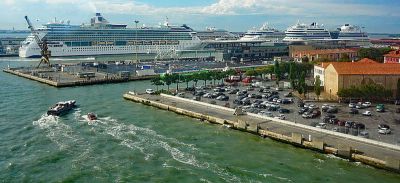When first reported, the ban of cruise ships larger than 40,000 tons in Venice was met with cheers of victory by local environmental groups and by those seeking some constraints on tourism. In questioning its implementation, though, the details are complicated.
The issue is where to dock the cruise ships to keep Venice a viable city for residents and for tourists. According to various reports, around 4,000 are employed in the tourism industry. Any changes in where a cruise ship docks changes the economies of two areas.
When looking at Venice from above, the main island in the lagoon is the city of Venice, the Historic Center. It is connected to the mainland by Ponte della Libertà. The bridge, a little over two miles long, has four lanes for road vehicles and two tracks for trains. In Venice, the bridge directs traffic to Venice’s transportation hub on its southwest corner, where the cruise ships dock at the Marittima Port. On the mainland, Porto Marghera, the industrial port, is just south of the bridge.
Cruise ships enter the Lagoon on the east from the Adriatic Sea, travel past the northern corner of Lido (barrier island between the sea and the Lagoon), round the southeastern tip of the historic city, and pass by Basilica di San Marco as they travel through the bends of the Giudecca Canal to dock at Marittima Port. The ships’ movements through the canal shift the sediment and increase erosion along the banks, damaging the foundation of the city.
The decree by the Italian government is not the first: bans have been announced in previous years, starting after the Costa Concordia ran aground off the coast of Tuscany in 2012. However, none have been enforced, primarily due to the lack of an acceptable plan for not only docking the ships, but also providing some type of transportation to bring tourists to Venice.
Guido Moltedo, founder and editor of the Venice-based magazine ytali notes: “According to the ‘decreto Trasporti,’ passed by the Senato (April 29), which will have to be approved by the Camera dei Deputati (chamber of parliament), the Port Authority of Alto Adriatico has 60 days to define ‘un concorso di idee’ for proposals to implement the guidelines of an off the lagoon port, but it does not suggest a timetable nor a deadline.”
Although a tangible deadline has not been established, both the cruise ship industry and UNESCO (Venice and its Lagoon were inscribed in 1987) have expressed concerns in implementing a viable plan. For the cruise ship industry, the comfort of its passengers and convenient access to Venice is paramount in providing a favorable travel itinerary, and some lines have already moved their homeports away from Venice. UNESCO has notified Italy that Venice is headed to its Endangered Sites list if action is not taken to reduce tourism and to prevent further erosion of the Lagoon.
To date, alternative options include moving the cruise ship port to Porto Marghera (on the mainland), requiring cruise ships to enter the Lagoon through the southern tip of Lido, dredging the canals or building a new port somewhere outside of the Lagoon. All have major concerns; particularly Porto Marghera which, as an industrial port, can be hazardous and could cause problems in managing both products and passengers at the port.
Luisella Romeo, a member of the Association of Registered Tourist Guides in Venice adds, “At the moment all merchandise and food which Venice needs for daily life arriving at the port in Marghera will get postponed if cruise ships dock in the same area, as passengers would have priority…Moreover, the cost that implies to bring the luggage and the passengers to the Marittima from the port in Marghera is not small, so this could push some ships to choose a different port.”
In the decree of the ban, a call for proposals was also announced, inviting groups to submit viable options. Residents of the historic city have been living through years of overtourism – the people and the immense cruise ships – and they offer experience and knowledge in dealing with the complexities of a ravaged Venice.
In her article about sustainably in Venice, Iris Loredana, who studied environmental science and wrote her thesis on the Lagoon of Venice, writes: “Moving cruise ships out of the Lagoon is a must: Experts of the universities of Venice and Padua agree that by excavating and dredging canals, the ecosystem of the Lagoon would be further damaged and its balance tilted beyond recovery. Currently, a solution is proposed by hydraulic experts teaching at the universities of the Veneto (notably Ca’ Foscari, Università degli Studi di Padova, Venice International University) to set up a floating port in the same place where it had been for more than 700 years, off the Cavallino peninsula [northeast of Venice]. Here, ships could dock and passengers [would] reach Venice on board smaller vessels.”
Could this be the viable solution?



